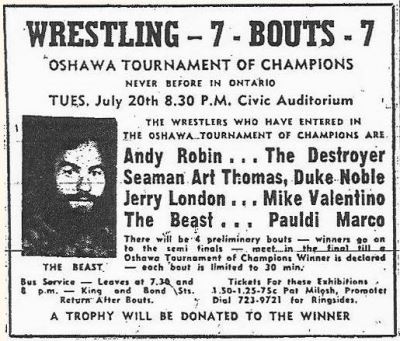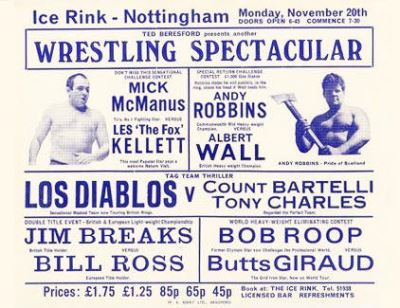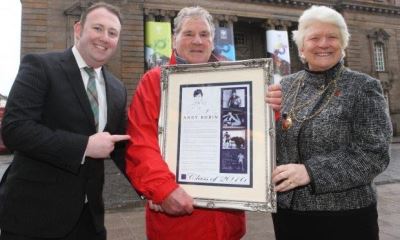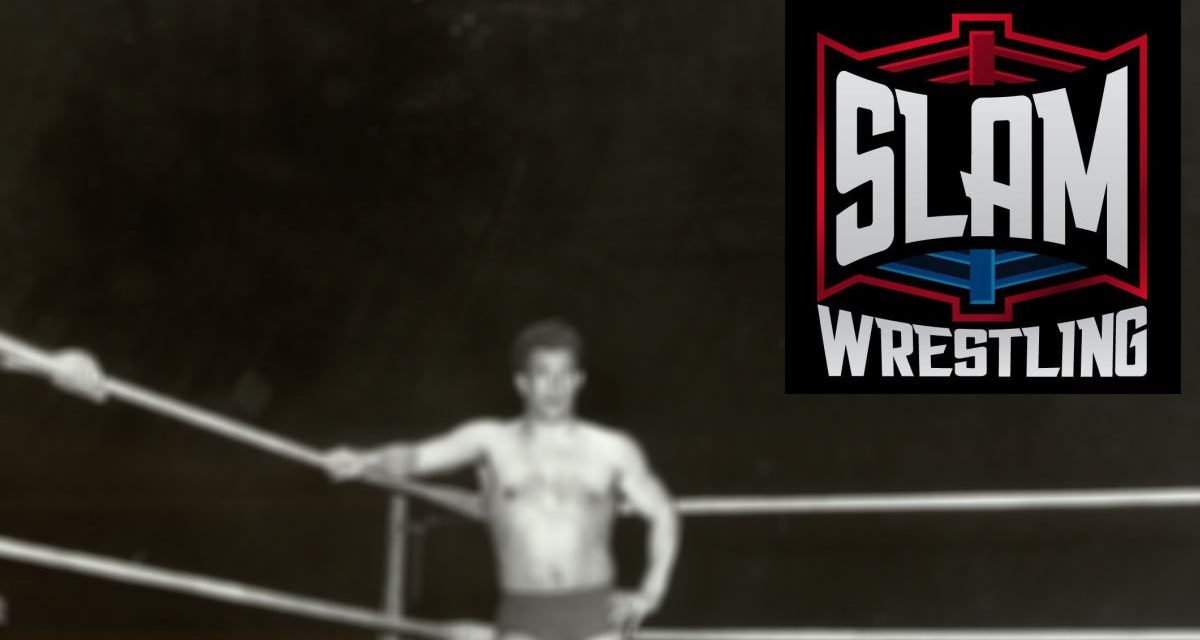In an industry filled with colourful characters, very few have had a life that could truly be considered the stuff of modern legend.
A bona fide folk hero, “Grizzly” Andy Robin became a national icon in Scotland, but was revered by wrestling fans on both sides of the Atlantic. His recent passing at the age of 84 has evoked a large number of tributes, and has become a major news story in his home country.

Andy Robin in Toronto. Photo by Roger Baker
The attention is understandable; it is due to the sheer fondness that the Scottish public had for him.
To wrestling audiences, Robin was resilient and defiant, a larger-than-life character that personified the bravery of the Scots. To his friends, Andy had a gentle spirit and cheeky sense of humour that was masked by his outward toughness. When he adopted a bear, some of his colleagues would even argue that he was a tad crazy.
But in his home country, Andy Robin symbolized the best of Scotland, and we loved him for it.
A “Son of the Rock,” Andrew Robin was born on August 31, 1935, in a small street beneath Stirling Castle. Interested in athletic competition and show business from an early age, Andy initially trained in boxing and gymnastics at a local hall. Blessed with natural strength and agility, Robin later excelled in a number of Highland Games contests, and he was crowned the World Cumberland Wrestling Champion at the age of twenty years old.
It was his participation in Highland Games events that led Andy to meet another wrestler, Willie Bell. Forming a partnership, they rapidly became renowned as two of the most successful amateur grapplers in Scotland.
Due to his success in traditional athletic competition, Andy was selected to perform in North America during a festival called “The Wonderful World of Sport,” as part of a Scottish national team who were to demonstrate Celtic games and introduce them to a new audience. It was during this tour that he met the professional wrestling promoter Frank Tunney, who approached Andy with an offer to work some bouts at the Maple Leaf Gardens in Toronto. Despite his relative inexperience in the professional wrestling circuit, Robin quickly impressed with his physical prowess and sense of showmanship that he had attained from years of performing to crowds at Highland events.
His first major international run working as a headlining fixture for the Tunney family would prove a success. Memorably, he would emergence victorious in the Oshawa Tournament of Champions on July 20, 1965. A single-elimination of seven matches, he went over stars such as “Seaman” Art Thomas, The Destroyer, Duke Noble, Jerry London, Mike Valentino, The Beast and Paul DeMarco to raise the trophy.

The newspaper ad from Robin’s win in Oshawa. Courtesy mapleleafwrestling.com
Nevertheless, after an exhausting two-and-a-half years tenure on the Canadian wrestling circuit, he missed Scotland and was keen to get back to his native soil.
Robin returned home with gold. Winning the British Commonwealth Mid-Heavyweight Championship, he vowed to defend his title with pride and joined the ranks of Joint Promotions. Joint was a syndicate of wrestling companies based in the United Kingdom, which had an organisational model similar to the old National Wrestling Alliance.
As a performer, Robin quickly solidified his status as a robust draw, with a unique persona that truly connected to British crowds, particularly in Scotland.
“To Scottish crowds, Andy Robin really was The Man. Nobody was as big a star here as he was. Although he was every promoter’s nightmare, he was every wrestling fan’s dream. He made every match special, and evoked a huge crowd support from the opening bell,” noted celebrated Scottish wrestler Frank “Chic” Cullen.
As a grappler, Robin was often presented as a lumberjack strongman, who fused solid mat fundamentals with incredible charisma. Famed for his brawling style and a crippling leg-hold dubbed “The Power Lock,” his career continued to flourish as he participated in matches broadcast on ITV’s World of Sport program.

A Nottingham card.
By 1972, Robin earned his second professional wrestling championship, capturing the British Commonwealth Middleweight title. However, Andy started to place his focus on a new venture. It was an enterprise which would challenge the skills he had acquired as a wrestler, and put them to their greatest test.
While in Canada, Andy had seen novelty bouts featuring wrestlers against a number of wild animals, including a muzzled bear named Terrible Ted. With this idea, Robin saw great potential. He quickly convinced his wife Maggie, a Scottish Ladies Show-Jumping Champion, that they should adopt a bear cub from the Highland Wildlife Park in Kingussie. Raising the animal as if it were their own child, the couple would eventually present the novel attraction of wrestling matches featuring Andy with his new find; Hercules The Bear.
It took significant effort and hard work to train Hercules, but the risk had been worth it; the act of a man wrestling an un-muzzled bear was an instant hit. The cute appeal of the “Big Softy” enabled Andy and Maggie to bring joy to millions across the world in their many public appearances with Hercules.
While the duo celebrated mainstream success, Andy was keen to use his name value to help boost the profile of the industry that first made him a star. Following the cancellation of British wrestling on terrestrial network television in 1988, Robin was one of the key draws who performed at a set of tapings produced by regional ITV franchisee Grampian Television in October 1990 at the Beach Leisure Centre in Aberdeen. Broadcast in January the following year, it was an early attempt to get a domestic product back on the network, which had started to showcase WCW Pro Wrestling on the air. Robin’s submission victory over masked mystery man The Phantom would end up being his final televised bout.
Over the course of his career, Andy Robin cemented his legacy as a daring pioneer who brought his amazing showmanship to professional wrestling and broadened its appeal to family audiences. Filled with generosity and a kindness of spirit, Robin was heavily involved in charity events and public appearances with Hercules, following his retirement from the ring in the early 1990s.

Bradley Craig, left, inducts Andy Robin into the Professional Wrestling Hall of Fame for Scotland, along with Liz Grant, Provost of Perth and Kinross.
On December 23, 2016, Andy Robin was inducted as the second member of the Professional Wrestling Hall of Fame for Scotland. His induction was presented by Liz Grant, Provost of Perth and Kinross, at a civic ceremony held at Perth City Hall, a venue which hosted many of Andy’s defining moments and championship battles. The induction received national television and newspaper coverage, and was a fitting tribute to a distinguished career that spanned five separate decades.
The following year, Andy Robin was bestowed another special accolade. He was asked to be the Chieftain at the 148th Gathering of the Blackford Highland Games on May 27, 2017. Attending with his wife Maggie, his pet dog Robbie, and some of his closest friends and family, it was a special day which celebrated Robin for his contributions to Highland Games events and allowed for his career to come full circle.
The story has been major news in Scotland, and was shown on BBC and ITV news, as well as in all the major newspapers. His final wish was to be buried beside his bear, Hercules.
RELATED LINKS
- The Professional Wrestling Hall of Fame for Scotland on Facebook
- June 13, 2024: Drew McIntyre inducted into Scotland’s wrestling hall of fame
- Sep. 8, 2022: ‘Wild’ Ian Campbell inducted into Professional Wrestling Hall of Fame for Scotland
- Oct. 22, 2021: Jim McKenzie added to Scotland’s Hall of Fame
- Dec. 21, 2020: Scotland’s Hall of Fame adds Charles ‘Chic’ Purvey
- June 30, 2019: Remembering Drew McDonald: Scottish Hall Of Famer

